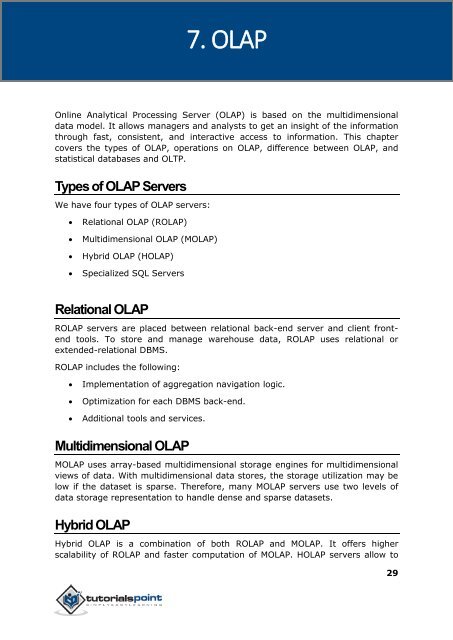dwh_tutorial
You also want an ePaper? Increase the reach of your titles
YUMPU automatically turns print PDFs into web optimized ePapers that Google loves.
7. OLAP<br />
DWH<br />
Online Analytical Processing Server (OLAP) is based on the multidimensional<br />
data model. It allows managers and analysts to get an insight of the information<br />
through fast, consistent, and interactive access to information. This chapter<br />
covers the types of OLAP, operations on OLAP, difference between OLAP, and<br />
statistical databases and OLTP.<br />
Types of OLAP Servers<br />
We have four types of OLAP servers:<br />
<br />
<br />
<br />
<br />
Relational OLAP (ROLAP)<br />
Multidimensional OLAP (MOLAP)<br />
Hybrid OLAP (HOLAP)<br />
Specialized SQL Servers<br />
Relational OLAP<br />
ROLAP servers are placed between relational back-end server and client frontend<br />
tools. To store and manage warehouse data, ROLAP uses relational or<br />
extended-relational DBMS.<br />
ROLAP includes the following:<br />
<br />
<br />
<br />
Implementation of aggregation navigation logic.<br />
Optimization for each DBMS back-end.<br />
Additional tools and services.<br />
Multidimensional OLAP<br />
MOLAP uses array-based multidimensional storage engines for multidimensional<br />
views of data. With multidimensional data stores, the storage utilization may be<br />
low if the dataset is sparse. Therefore, many MOLAP servers use two levels of<br />
data storage representation to handle dense and sparse datasets.<br />
Hybrid OLAP<br />
Hybrid OLAP is a combination of both ROLAP and MOLAP. It offers higher<br />
scalability of ROLAP and faster computation of MOLAP. HOLAP servers allow to<br />
29


